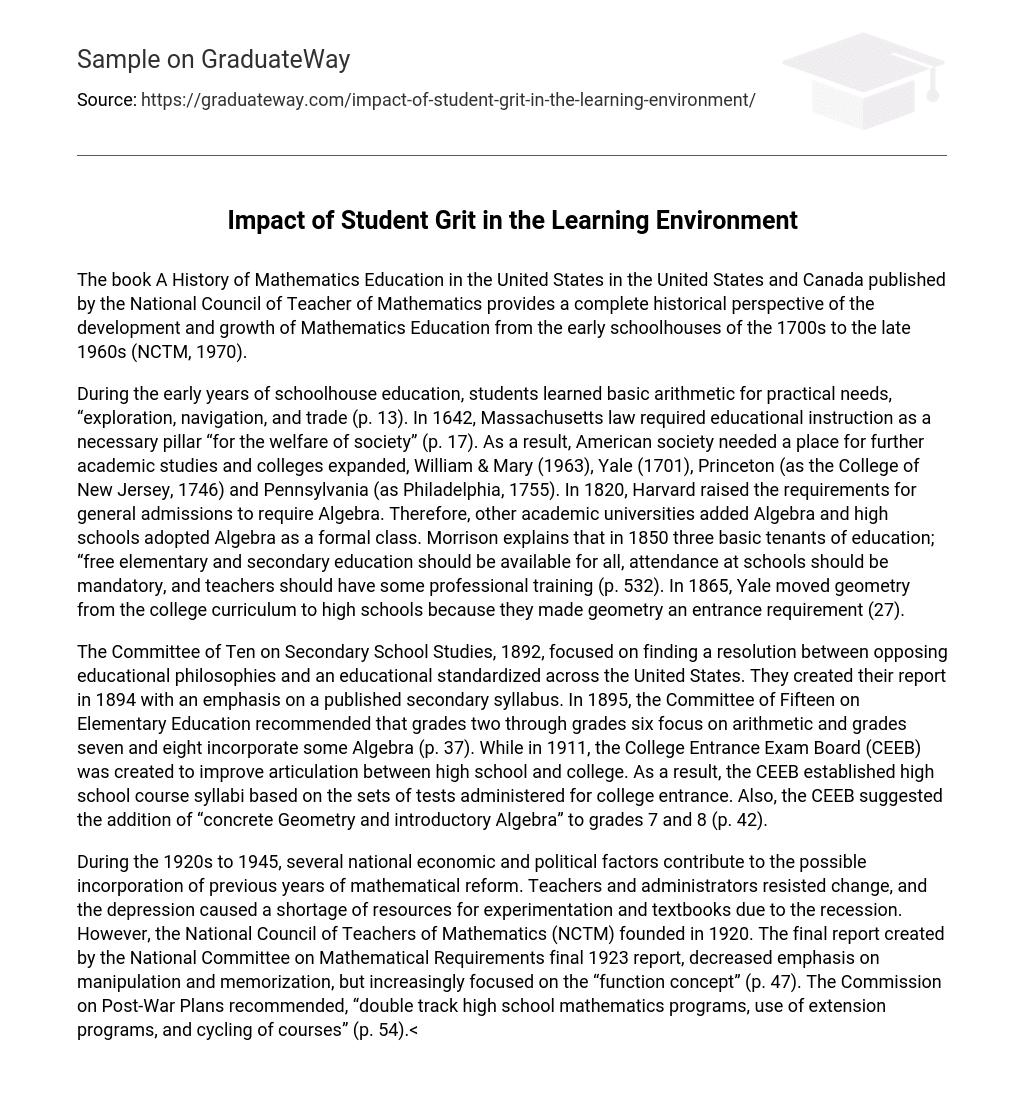The book A History of Mathematics Education in the United States in the United States and Canada published by the National Council of Teacher of Mathematics provides a complete historical perspective of the development and growth of Mathematics Education from the early schoolhouses of the 1700s to the late 1960s (NCTM, 1970).
During the early years of schoolhouse education, students learned basic arithmetic for practical needs, “exploration, navigation, and trade (p. 13). In 1642, Massachusetts law required educational instruction as a necessary pillar “for the welfare of society” (p. 17). As a result, American society needed a place for further academic studies and colleges expanded, William & Mary (1963), Yale (1701), Princeton (as the College of New Jersey, 1746) and Pennsylvania (as Philadelphia, 1755). In 1820, Harvard raised the requirements for general admissions to require Algebra. Therefore, other academic universities added Algebra and high schools adopted Algebra as a formal class. Morrison explains that in 1850 three basic tenants of education; “free elementary and secondary education should be available for all, attendance at schools should be mandatory, and teachers should have some professional training (p. 532). In 1865, Yale moved geometry from the college curriculum to high schools because they made geometry an entrance requirement (27).
The Committee of Ten on Secondary School Studies, 1892, focused on finding a resolution between opposing educational philosophies and an educational standardized across the United States. They created their report in 1894 with an emphasis on a published secondary syllabus. In 1895, the Committee of Fifteen on Elementary Education recommended that grades two through grades six focus on arithmetic and grades seven and eight incorporate some Algebra (p. 37). While in 1911, the College Entrance Exam Board (CEEB) was created to improve articulation between high school and college. As a result, the CEEB established high school course syllabi based on the sets of tests administered for college entrance. Also, the CEEB suggested the addition of “concrete Geometry and introductory Algebra” to grades 7 and 8 (p. 42).
During the 1920s to 1945, several national economic and political factors contribute to the possible incorporation of previous years of mathematical reform. Teachers and administrators resisted change, and the depression caused a shortage of resources for experimentation and textbooks due to the recession. However, the National Council of Teachers of Mathematics (NCTM) founded in 1920. The final report created by the National Committee on Mathematical Requirements final 1923 report, decreased emphasis on manipulation and memorization, but increasingly focused on the “function concept” (p. 47). The Commission on Post-War Plans recommended, “double track high school mathematics programs, use of extension programs, and cycling of courses” (p. 54).
The report of the Joint Commission, published in 1940, written by committee members of NCTM and the Mathematics Association of America (MAA), recommended two mathematics high school pathways with the incorporation of a spiraled curriculum. The traditional pathway consisted of a year of Algebra, Geometry, Intermediate Algebra, and Trigonometry or College Algebra. The alternative pathway incorporated an integrated approach. The Joint Commission also wrote a “Report on the Training of Teachers of Mathematics” (p. 62). They recommended future high school math teachers to take “college algebra, analytic geometry, calculus, a critical examination of Euclidean geometry with a brief introduction to other geometries, theory of equations, history of mathematics, advanced calculus, some modern algebra, and cognate work in a science” (p. 62). They also advised professional preparation to include a course on math teaching methods taught by an instructor who was a former high school math teacher.
The War Preparedness Committee in 1940 analyzed the Mathematics used in training manuals used by armed forces provided concrete evidence of weaknesses in high school graduates’ Mathematical abilities (p. 59). As a result, NCTM responded in 1943 with a published report “Essential Mathematics for Minimum Army Needs” that had a revitalizing effect on improving education and mathematics education standards across all grade levels (p. 59).
References
- Morrison, Samuel Eliot. The Oxford History of the American People. New York: Oxford University Press, 1965.





